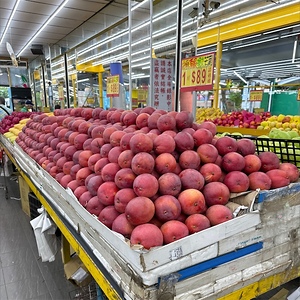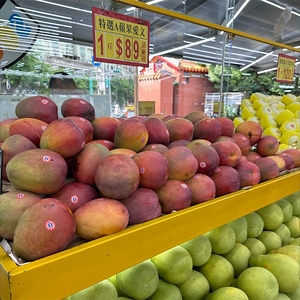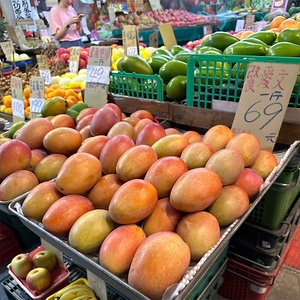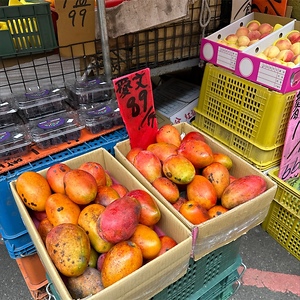


Irwin Mangoes
Estimated Inventory, lb : 0
Description/Taste
Irwin mangoes vary in size, depending on growing conditions and climate, but typically average 13 to 14 centimeters in length and 9 to 10 centimeters in diameter. The variety ranges from 300 to 500 grams in weight and has a round to oval shape with blunt, curved ends. Some Irwin mangoes may also display a slight point on the non-stem end. The mango’s skin is thin, smooth, and taut, transitioning from a matte bloom to a glossy, oily appearance with maturity. The skin ripens from green to shades of orange, pink, red, and burgundy, and the more exposed the fruits are to the sun during cultivation, the darker red they will become. Irwin mangoes also occasionally exhibit tiny pale lenticels on the surface. The skin peels easily, revealing a vibrant orange flesh that is soft, aqueous, tender, and fibreless with a succulent, melting consistency. The flesh also encases a small, central, oval to oblong, flattened, thin seed that is inedible and should be discarded. Irwin mangoes emit a honeyed, musky, tropical aroma when ripe. Select fruits that are heavy for their size, indicating high juice content. Irwin mangoes are edible raw once ripe and measure between 12 to 15 degrees Brix, creating a mild, sweet, subtly tangy, fruity, and floral taste.
Seasons/Availability
Irwin mangoes are grown in both hemispheres, and each region may have varying availability. The variety is typically harvested in the spring through mid-summer. In Japan and Florida, Irwin mangoes have a peak season in June and July. In Taiwan, Irwin mangoes are picked in two stages between April through mid-June.
Current Facts
Irwin mangoes, botanically classified as Mangifera indica, are an American variety that has become an important commercial cultivar worldwide, belonging to the Anacardiaceae family. The monoembryonic fruits were developed in Florida in the mid-20th century and were selected as a commercial cultivar for their productive nature, consistent yields, and dark red fruits. After their release, Irwin mangoes were shared with breeding programs worldwide, becoming a prevalent variety throughout Asia. Irwin mangoes are the most commercially produced variety in Taiwan, locally called Aiwen or Apple mangoes. They are also notably grown in greenhouses under specific conditions in Japan to create premium fruits sold under the name Miyazaki and Taiyo no Tamago. Consumers favor Irwin mangoes for their mild, sweet, and fruity taste, tender, fibreless texture, and attractive aesthetics. The fruits are produced for fresh markets worldwide and are purchased for both raw and cooked culinary preparations. Irwin mangoes are also sold for processing, making them into various frozen desserts, purees, and juices.
Nutritional Value
Irwin mangoes are a source of potassium to balance fluid levels within the body, fiber to regulate the digestive tract, and vitamin C to strengthen the immune system. The fruits also provide magnesium to control nerve functions, vitamin E to guard the cells against free radical damage, calcium to build strong bones and teeth, iron to develop the protein hemoglobin for oxygen transport through the bloodstream, and other nutrients, including vitamin K, folate, vitamin A, phosphorus, and B vitamins. Mangoes are believed to have cleansing properties and are consumed to help the digestive tract function properly.
Applications
Irwin mangoes have a mild, sweet flavor suited for fresh or cooked preparations. The fruits are primarily consumed straight out of hand and are appreciated for their tender, juicy, and fibreless flesh. Irwin mangoes can be easily peeled, and the flesh can be eaten directly off the seed. The flesh can also be sliced into wedges and served on fruit platters or used as a fresh topping over parfaits, salads, porridge, and ice cream. In Asia, Irwin mangoes are often sliced fresh and eaten with shaved ice as a cooling treat on hot summer days. They are also blended into juices and used to flavor smoothies, shakes, and bubble tea drinks. In addition to fresh preparations, Irwin mangoes are famously used in frozen treats. Green versions of the fruit are thinly sliced and fermented in a sugar syrup called mango ice. This sweet and tangy dish is a specialty dessert in Taiwan. Irwin mangoes are also peeled, sliced in half, and flash-frozen into healthy popsicles. The fruit’s fibreless flesh allows it to be blended and frozen into purees, sauces, and chunks for beverage use. Beyond frozen treats, Irwin mangoes are incorporated into jams, jellies, and syrups or used as fillings for baked goods and desserts. The variety also provides a sweet taste in puddings, custards, or tarts and is dried for extended use as a chewy snack. Irwin mangoes pair well with fruits such as pineapples, passion fruits, strawberries, bananas, kiwis, and coconut. Whole, unopened Irwin mangoes should be immediately consumed once ripe for the best quality and flavor. The mangoes should be left at room temperature to mature, and once ripe, they can be placed in the refrigerator for a few days to extend their shelf life.
Ethnic/Cultural Info
Douliuzai Village in the Yujing District of Tainan, Taiwan, has acquired the nickname of the “home of Aiwen mangoes.” Aiwen is the common name for Irwin mangoes in Taiwan. Before the introduction of Irwin mangoes in the 1960s, Douliuzai Village was considered the poorest community within the Yujing District. During this time, the Taiwan Agricultural Research Institute selected several American mango varieties for import in an effort to increase the commercial mango industry. Irwin mangoes arrived in 1954, and agricultural breeder Lu Chih-Lin began promoting the planting of Irwin mangoes in communities throughout Southern Taiwan. Douliuzai Village resident Cheng Han-Chih heard about the new American variety and partnered with Lu Chih-Lin to plant Irwin mangoes in his home garden. Han-Chih planted 100 Irwin mango saplings, but shortly after, only 4 of the 100 trees survived due to weather. Han-Chih persevered and planted another 100 seedlings the following year, and in 1965, the trees began bearing fruit. Irwin mangoes slowly increased in popularity throughout Taiwan, and as they continued to rise in fame, Han-Chih inspired many other Douliuzai Village residents to plant Irwin mangoes. Mango production reinvigorated the village economy, and by 1967, Douliuzai became a well-known, successful, and wealthy community. Cheng Han-Chih was declared the “Father of Taiwan’s Aiwen mangoes” in 2018 after his passing, and a plaque was erected at Cheng Han-Chih’s home by the Tainan City Government to honor the dedicated fruit breeder. Douliuzai has also become a special mango-growing region, attracting visitors each year. The community features a mango statue, and local shops display mango-theme souvenirs, pastries, frozen treats, and dried goods. Tourists also visit one of the four surviving Irwin mango trees on Cheng Han-Chih’s property. The tree is over 62 years old and still produces fruit. In 2022, the tree produced 296 mangoes sold by the Douliuzai community.
Geography/History
Irwin mangoes are native to Florida and were developed by breeder F.D. Irwin in Miami. The variety was created in 1939 from a cross between Lippens and Haden mangoes, and the tree first bore fruit in 1945. The cultivar was named Irwin after its breeder in 1949 and was released that same year as a commercial cultivar throughout South Florida. In 1954, several American varieties, including Irwin mangoes, were introduced to Taiwan, and Irwin mangoes were planted in Southern Taiwan in 1962. The variety eventually became the top commercial cultivar of the country for domestic sales and export. Irwin mangoes were also planted in Japan in the 1980s and in other countries worldwide as mango cultivation increased for commercial markets. Today, Irwin mangoes are widely grown in tropical and subtropical climates. In Taiwan, the variety is primarily cultivated in the Yujing district in Tainan and Fangshan and Nanhua in Pintung County and is exported seasonally to Singapore, Korea, Hong Kong, and Japan. Irwin mangoes are also produced in orchards and greenhouses in Japan, South Korea, China, Australia, Central America, Southern Africa, Israel, and the United States. The Irwin mangoes featured in the photograph above were sourced through markets in Taipei, Taiwan.











